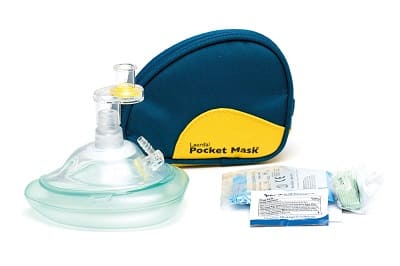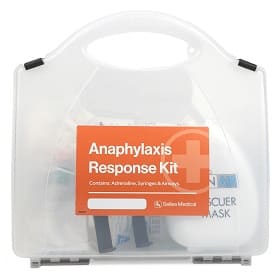Home › Diving Guide › Scuba Gear › Accessories › First Aid Supplies
Supplies for Customised First Aid Kit
An alliance between effective teamwork and the use of specialised equipment in emergency responses reduces the risks for rescuers and the victims.
This guide explains how adding some specific items to a regular first aid kit can improve outcomes when managing diver emergencies.
Customising a First Aid Kit for Scuba Diving
An emergency response is more likely to be effective and successful if it follows a set plan.
When treating injured scuba divers, the PADI® Emergency Action Plan will guide you. Your EAP should consider:
- Yourself and members in your rescue team
- Other divers (where applicable)
- Local emergency response team (EMS, fire department)
- The local medical services (hospitals)
A standard first aid kit is a collection of supplies and equipment for use when administering first aid. When you're assembling a first aid kit for scuba divers, it should contain the appropriate components for the purpose.
Common contents include items to help control arterial bleeding, such as bandages, protective breathing barriers for CPR, and some medicines.
Pro Tip: Keep all the contents of a first aid kit clean and dry. Check them at regular intervals and restock as and when necessary, such as damaged or out of date, especially seasickness medication stored on large dive boats.
Pocket Mask for CPR
A pocket mask, also called a CPR mask, is a device used to safely deliver rescue breaths during a cardiac arrest or respiratory arrest. Thus, a responder can administer air into the patient's mouth, nose, and lungs by exhaling into (through) the one-way filter valve.
 Most of the modern pocket masks have either a built in one-way valve or an attachable, disposable filter.
Most of the modern pocket masks have either a built in one-way valve or an attachable, disposable filter.
This component helps to protect emergency responders from contact with potentially infectious bodily substances, such as saliva, vomit, and blood.
New CPR masks also have a built-in oxygen intake tube. This allows for the administration of up to 50-60% oxygen - when combined with a supplemental supply unit.
Not being hooked up to an external line means exhaled air from the responder (up to 16%) may still provide sufficient oxygen for survival.
Pro Tip: The content is substantially less than the 21% oxygen in the atmosphere at sea level. Scuba divers (and non-divers) can learn more in the PADI Emergency Oxygen Provider Specialty course.
Emergency Oxygen Unit
According to the recent diving accident reports (by DAN), less than 33% of injured divers actually get emergency oxygen in the field. Plus, even fewer receive oxygen concentrations approaching the industry recommendation of 100%.
DAN, and all major scuba diving instructional agencies, recommend that all divers should be qualified to provide 100% oxygen in the field to anyone injured in a dive accident.
Here's the thing:
Nowadays, some kind of portable oxygen unit is standard emergency equipment at most dive sites. You can buy them in sturdy watertight plastic storage box containers.
Using Oxygen Units
Remember the two 'Es' as important safety protocols anytime you deliver high concentrations of oxygen. The first 'E' stands for the 'Environment'. Thus, extinguish all naked flames and provide ample ventilation in small confined spaces.
The second 'E' stands for 'Equipment'. So, determine how long the oxygen supply will last - and never let the unit run empty while it's attached to the patient.
Anaphylaxis Response Kit
Make sure you follow all relevant protocols and have the right equipment and appropriate medicines for managing anaphylaxis.
 All anaphylaxis response kits should contain:
All anaphylaxis response kits should contain:
- Adrenaline 1:1000 (including a minimum of three (3) ampoules within expiry dates)
- At least three x 1 mL syringes and 25 mm needles (used to perform an intramuscular injection)
- Cotton wool swabs
- Pen and paper (e.g. to make a record of the time you administered the adrenaline)
- It's also recommended to keep laminated copies of the Immunisation Handbook
Pro Tip: Make sure the contents are up to date and not expired if you are keeping an anaphylaxis response kit as part of your first aid supplies checklist.